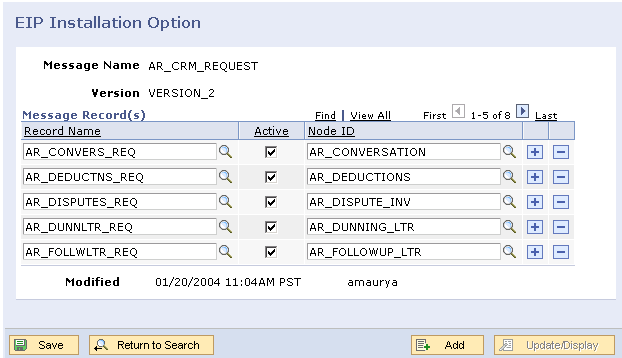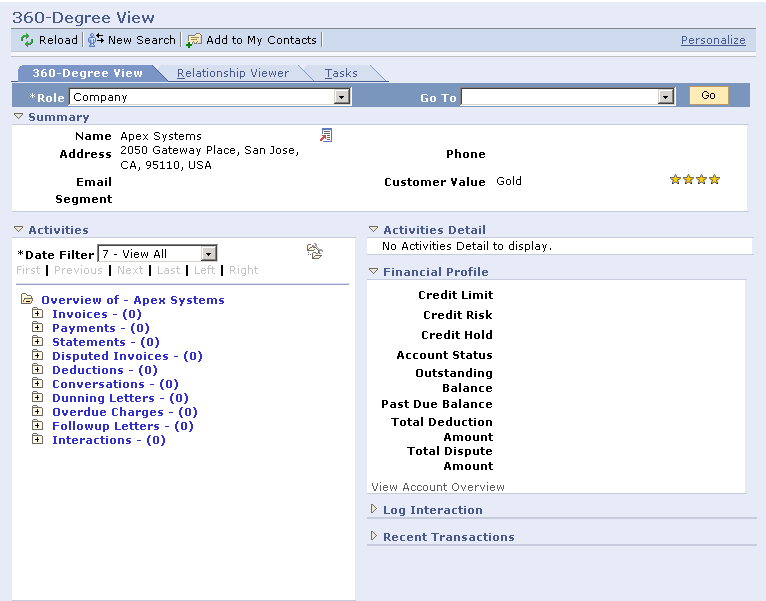
 Understanding Integration Between Accounts Receivable and the 360 - View
Understanding Integration Between Accounts Receivable and the 360 - View
This chapter provides overviews of the integration between Accounts Receivable and the 360 - Degree View, and nodes.

 Understanding Integration Between Accounts Receivable and the 360 - View
Understanding Integration Between Accounts Receivable and the 360 - View
Displaying Accounts Receivable information as part of the 360 - Degree view completes the financial view of the customer. The Financial Profile section is always visible, but is configurable so administrators have the option to hide some of the data. The integration between AR and the 360 - Degree view has a total of nine integration points: eight with AR and one with Billing. The setup in the 360 - Degree view enterprise integration points options determines what data is requested from the FSCM application.When CRM sends a request message to the FSCM application, it looks at the AR/360 - Degree view EIP setup options and builds the message to fetch only those EIPs that are enabled.
The following screenshot displays the EIP Installation Option page:

EIP Installation Option page
The following information is sent from the CRM Request message:
|
Integration Point |
Field Name |
Description |
|
Financial Profile |
OPRID |
User ID |
|
Financial Profile |
SETID |
Set ID |
|
Financial Profile |
BILL_TO_CUST_ID |
Bill to Customer ID |
|
Financial Profile |
START_DT |
Start Date |
|
Financial Profile |
END_DT |
End Date |
|
Financial Profile |
ORDERBY_FLD |
Order By Field |
|
Financial Profile |
MAX_ROWS_FETCH |
Max Rows to Fetch |
|
Financial Profile |
BO_ID_CUST |
CRM Customers BO ID |
|
Financial Profile |
ROLE_TYPE_ID_CUST |
CRM Customers Role Type ID |
|
Financial Profile |
BO_ID_CNTCT |
CRM Contact’s BO ID |
|
Financial Profile |
ROLE_TYPE_ID_CNTCT |
CRM Contact’s Role Type ID |
|
Payment, Conversations, Deductions, Disputes, Dunning Letter, Follow Up Letter, Overdue, and Statement |
ORDERBY_FLD |
Order by Field |
|
Payment, Conversations, Deductions, Disputes, Dunning Letter, Follow Up Letter, Overdue, and Statement |
MAX_ROWS_FETCH |
Max Rows to Fetch |
See Also
PeopleSoft Enterprise CRM 8.9 Application Fundamentals PeopleBook

 Financial Profile
Financial ProfileThe financial profile of the customer is displayed as a sub-page on the 360 - View tree. It is configurable.

 Messages
MessagesTwo message structures exist in PeopleSoft CRM to handle requests from CRM to AR and responses from AR to CRM.
The request structure (AR_CRM_REQUEST) contains one parent record to initiate the request for the Bill To Customer and indicates if customer status information should be returned. This structure also contains seven child records to indicate how many rows should be returned. This value is dependent upon the setup in the EIP Install Options. Each child record should contain only one row in the rowset.
The response structure (AR_CRM_RESPONSE) contains one parent record to return customer status information. This structure also contains eight child records to return the various transaction types requested. Each child record can contain zero to many rows in the rowset.
Warning! There are two versions of the relationship used in Integration Broker with Interaction Management. Version 1 of this relationship is used for PeopleSoft CRM 8.8. Version 2 of the relationship is used for PeopleSoft Enterprise CRM 8.9. Having these two different versions of the relationships allows backward compatibility of this integration.

 Understanding Nodes
Understanding NodesDate filters are always applied to nodes.
Nodes are delivered in the tree as follows:

360 - Degree view nodes
Note. Not checking the Apply Date Filter check box may result in a large amount of data being retrieved which may cause performance degradation.
Only those account statements associated with the specified customer and within the Start Date and End Date range are retrieved by FSCM. When an account statement is selected, control transfers to FSCM.
The response message includes the following fields from FSCM:
|
Field Name |
Description |
|
SETID |
SetID |
|
BILL_TO_CUST_ID |
Bill to Customer ID |
|
CRSPD_SETID |
Correspondence SetID |
|
CRSPD_CUST_ID |
Correspondence Customer ID |
|
ST_ID_NUM |
Statement Number |
|
ST_DT |
Statement Date |
|
BAL_AMT |
Statement Total Amount |
|
BAL_CURENCY |
Statement Currency Code |
|
TOTAL_ROW_COUNT |
Total Row Count |
Disputed invoices are those which the customer is disputing. FSCM delivers only unresolved disputed invoices within a particular date range.
The response message includes the following fields from FSCM:
|
Field Name |
Field Description |
|
SETID |
Set Id |
|
BILL_TO_CUST_ID |
Bill to Customer Id |
|
BUSINESS_UNIT |
Business Unit |
|
ITEM |
Item |
|
ITEM_LINE |
Item Line |
|
BAL_AMT |
Item Balance Amount |
|
BAL_CURRENCY |
Item Balance Currency |
|
ACCOUNTING_DT |
Accounting Date |
|
DUE_DT |
Due Date |
|
ENTRY_TYPE |
Entry Type |
|
ENTRY_REASON |
Entry Reason |
|
ORIG_ITEM_AMT |
Original Item Amount |
|
DISPUTE_STATUS |
Dispute Status |
|
DISPUTE_DT |
Dispute Date |
|
DISPUTE_AMOUNT |
Dispute Amount |
|
CR_ANALYST |
Credit Analyst |
|
COLLECTOR |
Collector |
|
SALES_PERSON |
Sales Person |
|
AR_SPECIALIST |
AR Specialist |
|
TOTAL_ROW_COUNT |
Total Row Count |
Deductions are invoices indicating deductions from the invoice (bill) due to promotions or incentives to the customer. FSCM delivers only unresolved deduction invoices within a particular date range.
The response message includes the following fields from FSCM:
|
Field Name |
Description |
|
SETID |
Set Id |
|
BILL_TO_CUST_ID |
Bill to Customer Id |
|
BUSINESS_UNIT |
Business Unit |
|
ITEM |
Item |
|
ITEM_LINE |
Item Line |
|
BAL_AMT |
Item Balance Amount |
|
BAL_CURRENCY |
Item Balance Currency |
|
ACCOUNTING_DT |
Accounting Date |
|
DUE_DT |
Due Date |
|
ENTRY_TYPE |
Entry Type |
|
ENTRY_REASON |
Entry Reason |
|
ORIG_ITEM_AMT |
Original Item Amount |
|
DEDUCTION_STATUS |
Deduction Status |
|
DEDUCTION_DT |
Deduction Date |
|
CR_ANALYST |
Credit Analyst |
|
COLLECTOR |
Collector |
|
SALES_PERSON |
Sales Person |
|
AR_SPECIALIST |
AR Specialist |
|
TOTAL_ROW_COUNT |
Total Row Count |
these are the conversations recorded by the collection agent for the customer. All conversations within a given date range are delivered.
The response message includes the following fields from FSCM:
|
Field Name |
Description |
|
SETID |
Set Id |
|
BILL_TO_CUST_ID |
Bill to Customer Id |
|
CONVER_DTTM_INIT |
Initial Conversation Date Time |
|
CONVER_DT |
Conversation Date |
|
DESCR |
Description |
|
CONVER_STATUS |
Conversation Status |
|
CONVER_STATUS_XLAT |
Conversation Status Translate Value |
|
CONVER_SUBJECT |
Conversation Subject |
|
CONVER_SUB_TOPIC |
Conversation Sub Topic |
|
THREAD_COUNT1 |
Thread Count / Number of Entries |
|
ATTACH_EXIST |
Attachment Exists |
|
TOTAL_ROW_COUNT |
Total Row Count |
|
ROW_ADDED_DTTM |
Date Created |
Dunning letters (DUN notices) are demands for payments. They are displayed as a node in the 360 - Degree view tree. The response message delivers both resolved and unresolved DUN notices for a given date range.
The response message should include the following fields from FSCM:
|
Field Name |
Description |
|
SETID |
SetID |
|
BILL_TO_CUST_ID |
Bill to Customer ID |
|
CRSPD_SETID |
Correspondence SetID |
|
CRSPD_CUST ID |
Correspondence Customer ID |
|
DUN_ID_NUM |
Dunning Number |
|
DUN_DT |
Dunning Date |
|
LETTER_CD |
Dunning Letter Code |
|
BAL_AMT |
Dunning Letter Total Amount |
|
BAL_CURRENCY |
Dunning Letter Currency Code |
|
TOTAL_ROW_COUNT |
Total Row Count |
Overdue charges are additional charges generated for past due invoices.
The response message includes the following fields from FSCM:
|
Field Name |
Description |
|
SETID |
Set Id |
|
BILL_TO_CUST_ID |
Bill to Customer Id |
|
CRSPD_SETID |
Correspondence Set Id |
|
CRSPD_CUST_ID |
Correspondence Customer Id |
|
OC_ID_NUM |
Overdue Charge Number |
|
OC_DT |
Overdue Charge Date |
|
BAL_AMT |
Overdue Amount |
|
BAL_CURRENCY |
Overdue Currency Code |
|
TOTAL_ROW_COUNT |
Total Row Count |
Follow-up correspondence displays the recent interactions with a particular customer within a specified date range.
The response message includes the following fields from FSCM:
|
Field Name |
Description |
|
SETID |
SetID |
|
BILL_TO_CUST_ID |
Bill to Customer ID |
|
CRSPD_SETID |
Correspondence SetID |
|
CRSPD_CUST_ID |
Correspondence Customer ID |
|
CONVER_DTTM_INIT |
Initial Conversation Date Time |
|
CONVER_DT |
Conversation Date |
|
LETTER_CD |
Letter Code |
|
FOLLOW_UP_DT |
Follow up date |
|
TOTAL_ROW_COUNT |
Total Row Count |
See Also
Interactions and 360-Degree Views